
Contact Manager
Phone:
+64 21 620 456
16 Kauri Street, Woburn, Hutt City, New Zealand
email:
Manager@virtual.co.nz
 |
Unbounded Human Energy
Many organisations start with two or three people who are enthusiastic about achieving an exciting vision, usually it’s to do with meeting a customer need or improving humanity. The vision is clear and the energy to achieve it is sky-high.

As time goes by more people are recruited to achieve the vision.
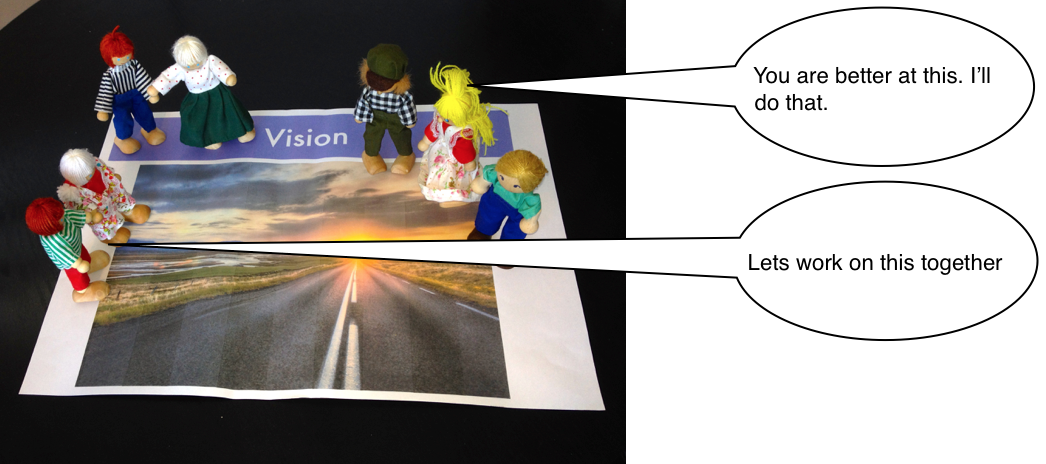
Then they grow even bigger and decide to bring in management consulting advice. The consultants says: “You need more control, more structure and more rules. It’s too risky to let people run free; you’ll get chaos. Divisionalise!.” Unfortunately, as the picture shows, this makes it impossible for the people to even see the vision. And the managers of each Division start to compete with each other.
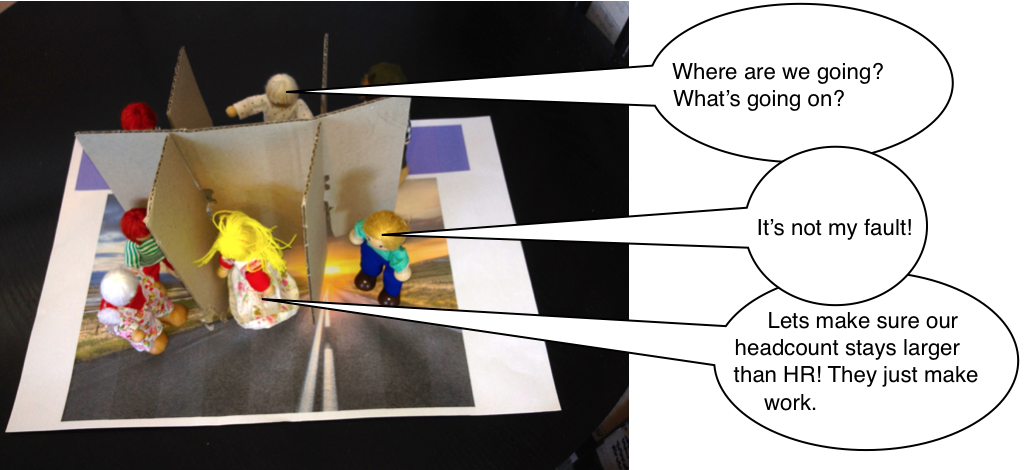
But it gets worse. Within each Division, people are further cut off from each other and the Vision by giving each person a narrowly specified job. Management says: “Of course we need jobs. How else can we hold people accountable?”
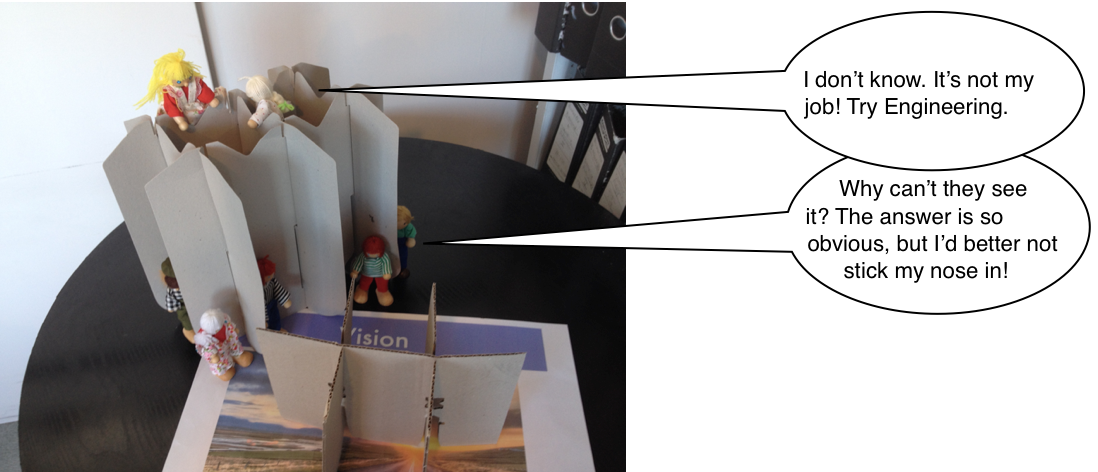
Each Division works like crazy on things that make sense to them but may not make sense to the organisation as a whole. Human Resources introduce work regulations and other processes. Strategy and Planning introduce Strategic Plans, Operational Plans and Budgets. Legal introduce laws and regulations. Procurement, Engineering, Marketing, Accounting and Senior Management get in on the act also. Before long, even if people could see the vision they are overwhelmed and don’t have the time or focus for it or the customer.
These are the issues I have been working on since 1992 when Virtual Group Business Consultants Group was founded: breaking down silos, building connections and trust, opening communications and reducing complexity by removing unnecessary boundaries, barriers, rules, processes and top-down management.
Virtual Group was launched in a pin-striped tent; our symbol of pin-striped quality, canvass-thin structure and total mobility. Our Vision then and ever since has been, “Liberating the Human Spirit at Work.” Our motto was and continues to be “Wisdom Without Walls” - our way of describing unbounded energy. Today many of our clients want to work in a more “Virtual - way”, including bottom-up, emergent business processes to support self-organisation and self management that liberates human energy at work.
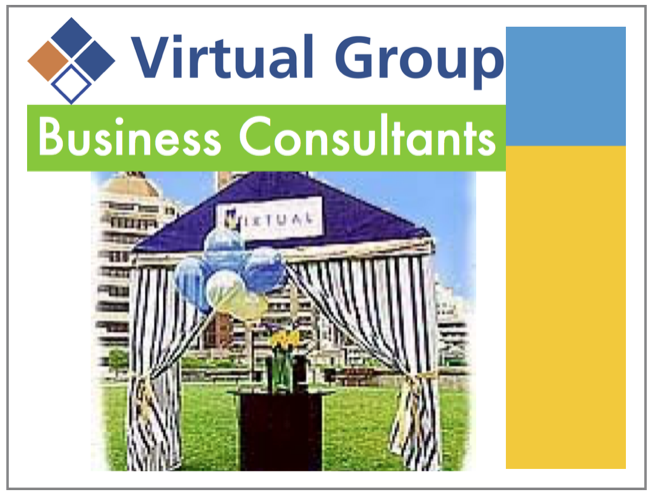
Self-organisation Without Top-down Control
For the last 30 years scientists have known something that very few managers know about - that there is a “sweet spot” at which all living systems have the ability to self-organise without any top-down control. This sweet spot occurs near what scientists call the “edge of chaos” (or the edge of order, as I’d rather describe it) where the system is delicately poised between one steady state and another steady state. For example, the membrane around every living cell in your body is neither solid nor water. Rather it is a delicate balance between solid and water. It’s just solid enough to hold some sort of form and liquid enough to allow movement in and out of the cell so the cell can interact with its environment. This is the image we need for business, just solid enough to give some sort of form/meaning and open enough to its environment to allow movement (of people, ideas and information) in and out.
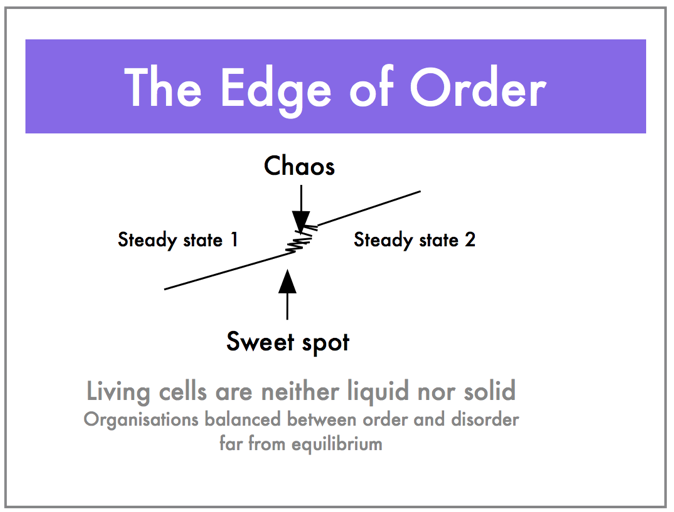
Many managers, especially in hierarchies, make the system too ordered. They fiddle with top-down control, just as they'd fiddle with their car. They fiddle at centralising, cutting back or reengineering. They downsize, control and impose as though it was a mechanical system (rather than a living system). This takes so much organisational energy, there's none left to satisfy customers, and staff are too battered to care. The sad thing is, science is now showing that most of this activity is counter-productive and can only lead to failure. The paradox is that over control leads to less order and less control leads to more order.
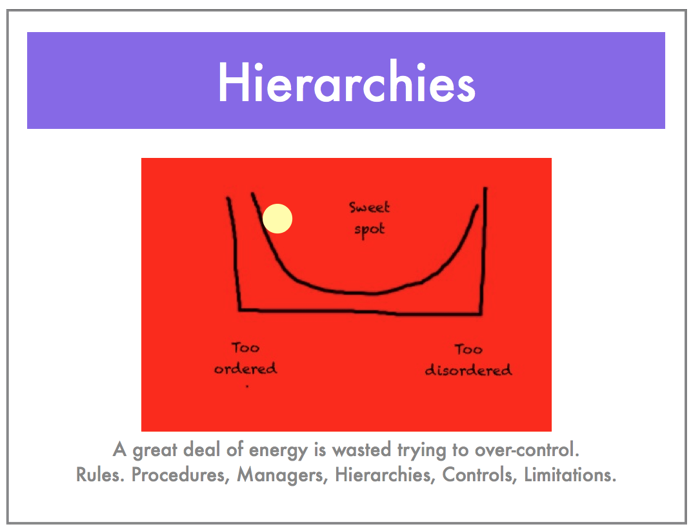
When too much order doesn’t work (and it won’t because it can’t) managers flip to the opposite extreme and the system becomes too disordered and behaves like mob-rule. A great deal of energy is wasted fighting turf battles and trying to survive and protect against unruly behaviour.

I’m sure you have seen this mad waltz. Round and round they go, flip-flopping from centralisation to decentralisation. It’s a never-ending, soul-destroying, energy-sapping dance; and it’s totally unnecessary.
If managers want to reach the sweet spot and achieve unbounded energy, all they need to do is understand and trust the laws of living systems, establish a powerful vision, then replace the excessive controls with three or four simple rules that everyone agrees to follow. When they do, their organisation will self-organise at the sweet spot where all the human energy is available to the organisation.
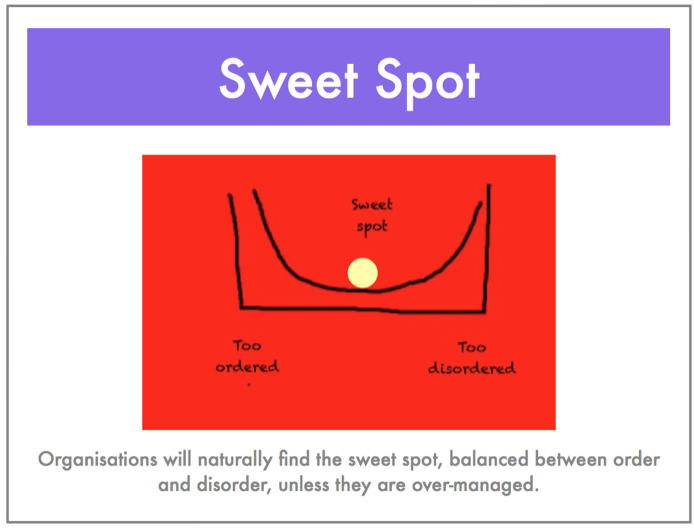
If this all sounds a bit theoretical, I make no apology because I have found that managers are sensible. They behave in ways that make sense in the world as they understand it. Therefore, before we can get managers to change their behaviours we need to get them to change the way they understand how the world works; that is, like the scientists say it does.
Remembering the Vision
Now lets get practical. Usually the first step towards unbounded human energy is remembering the vision that originally excited the founders.
In 1992 when I left the Bank of New Zealand to establish Virtual Group one of the first things I did was to get a new business card. It read: "Change Agent.” Back then, I really believed that change was what mattered. I saw it as necessary for growing and progressing. I now think I was wrong. As I've got older and wiser I've come to realise that far more important than change, is to understand what is constant. The real power lies in what is unchanging, what is always the same, what is the essence of the thing. Often this means understanding, rediscovering and honouring the original purpose and dreams of the founders.
For example, over the last 22 years as we struggled with the daily challenges of making Virtual Group work, sometimes we complicated our dream, sometimes we even forgot it. Whenever this happened the power of unbounded human energy fell away until we realised what was happening and refocused on the original dream of “Wisdom Without Walls.”.
Organisational structure
Second, managers need to change the way they think about the organisation structure to ensure it works in a world where self-organisation occurs without top-down control. Instead of towers with thick impervious walls and silos of power we need beanbags.
Towers are run like Stalin ran the USSR. They are command structures, highly centralised, rigid and tall. They are made up of equally rigid and tall silos called Divisions (how I hate that word). When the environment changes rigid, tall structures are fundamentally unstable... apt to fall over. And, like Russia, when it happens they fall fast.
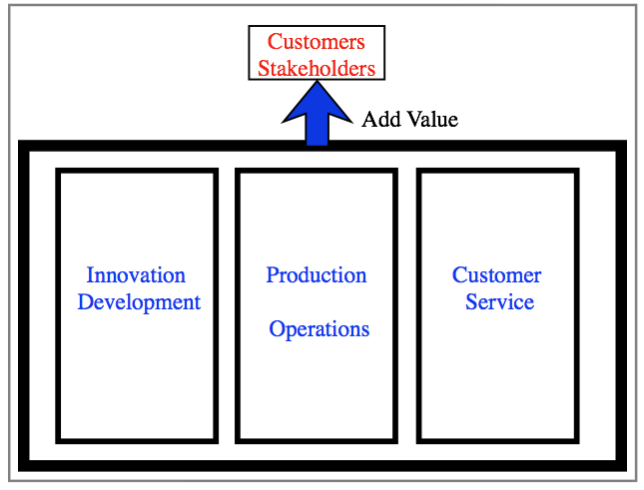
People in towers tend to be separate from each other with little connection or communication. The walls around the organisation (and between the individual Divisions) are thick, rigid and impervious. Within each Division people usually work hard, but because they are separate from the organisation as a whole, separate from other Divisions, and have lost sight of the vision, they tend to work to maximise the results of their Division rather than the results of the organisation as a whole.
Beanbags fit exactly to the shape of the environment no matter how much it changes. The bits inside are free to move wherever they want and as a result the structure as a whole becomes far more stable and fits minutely into its environment.
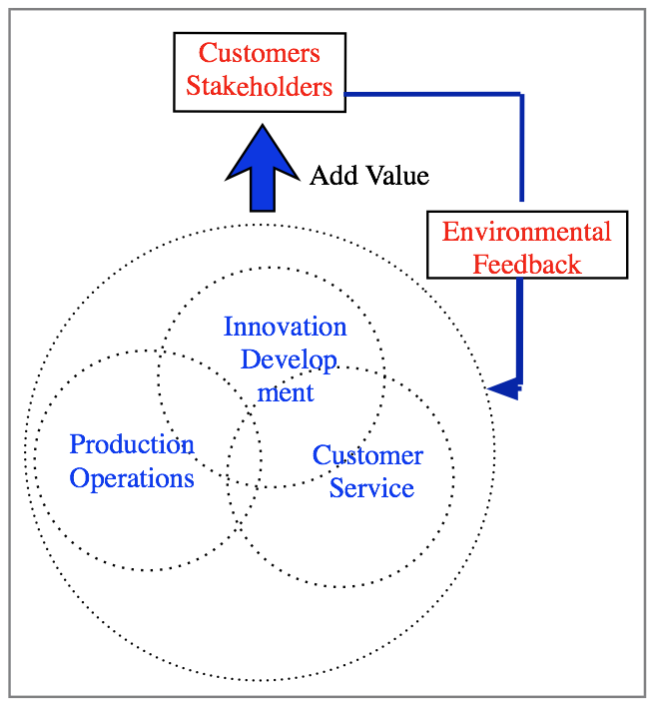
People in Beanbags tend to be connected to each other with open communication and collaboration between those who are important to getting the work done. The walls around the organisation (and the individual Centres of Excellence) are open, pervious, and overlapping so people can move in and out as required to do the work. Also the feedback loop is far stronger.
Narrowly defined jobs are the enemy of unbounded energy. In towers, work is divided up into narrowly defined jobs (eg Input Clerk). When people leave, managers try to find someone to fill the job, like a mechanic tries to find a spare part when a component needs replacing. Unfortunately people are not all the same size or shape as a spare part and the replacement may not fit snugly into the job. Unbounded energy comes when work is divided into larger projects (eg Development of Product A) that several people with complementary skills can work on together so each person works to their strengths and no one works to their weaknesses.
Process Structure
Third, managers need to rethink processes. Processes are vitally important to achieving results in organisations; however, they need to be designed from start to finish to serve the customer.
Too often processes, rules and procedures are introduced by people within a Division to try to maximise the performance of the Division without any thought of the impact on the customer or the organisation as a whole. Sometimes they are even introduced to make work and make the Divisional person look important. These rules, procedures and processes sometimes work against each other and are so detrimental to the whole that people feel like they are riding a cycle with square wheels. Once processes are introduced they tend to take on a life of their own and continue well after their use-by-date.
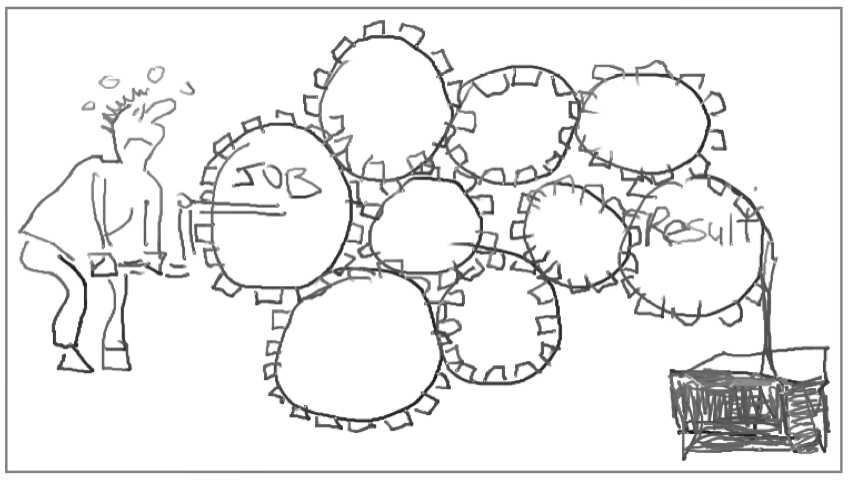
Managers need to simplify, improve and speed up each process to ensure that it is necessary, adds value to the customer and makes work easier. Many managers fail to understand that even removing a few steps in a process reduces effort exponentially. When people get rid of the square wheels they have time for each other and the customer.
The aim is to Shorten, Streamline, Speedup, Simplify, and Standardise.
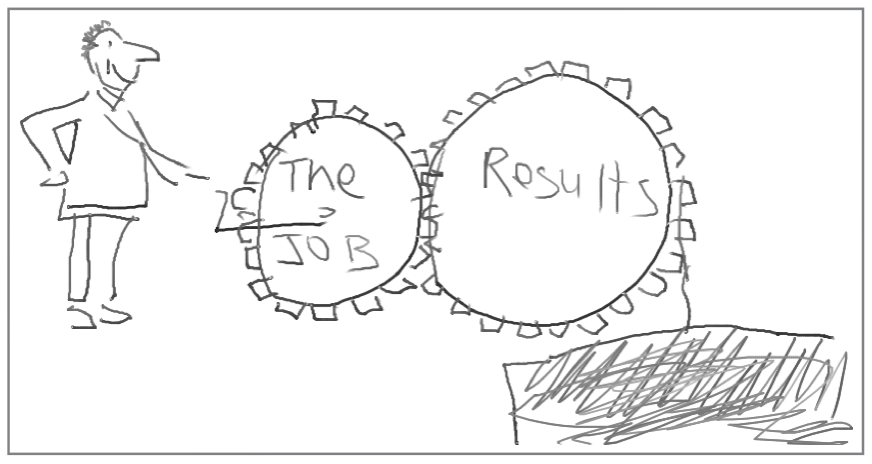
Barriers of Mind
Fourth, managers need to rethink culture and individual beliefs. I have found that the biggest barriers to unbounded human energy are barriers of the mind. There is some madness within the human mind that makes us want to break things up, put walls around them and put them in separate categories even when there is no need to.
Again the scientists are telling us that we are far more connected than most of us believe.
"A human being is a part of the whole called the 'universe,' a part limited in time and space. He experiences himself, his thoughts and feelings, as something separated from the rest, a kind of optical delusion of consciousness. This delusion is a kind of prison for us, restricting us to our personal desires and to affection for a few persons nearest to us. Our task must be to free ourselves from this prison by widening our circle of compassion to embrace all living creatures and the whole of nature in all its beauty. Nobody is able to achieve this completely, but the striving for such achievement is in itself part of the liberation and a foundation for inner security." ALBERT EINSTEIN
To achieve unbounded human energy managers need to develop an eye that looks between. Instead of seeing the following chart as just two separate faces (say Bruce and Peter), they also need to see the space in between. This space is not empty space, it is full of energy, trust (or lack of it) and communication (or lack of it).
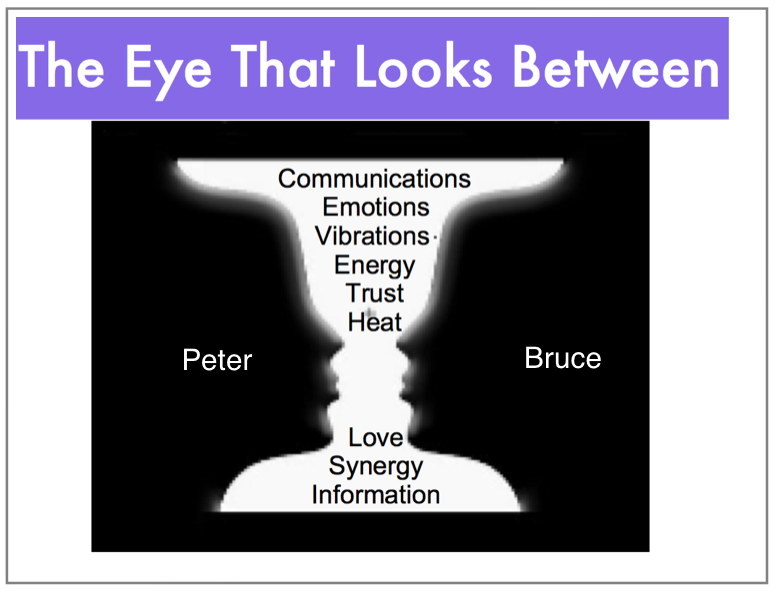
Achieving unbounded energy is far more than just removing barriers (organisational towers, restrictive jobs and square wheels) that previously sapped energy and made people frustrated, angry and internally competitive, but it is a necessary part. Once the organisation is opened up, people, information and resources flow more freely through pervious walls into overlapping centres of excellence. People start to talk where no one had talked before. Communication and trust build as people connect and are able to work together. Energy, communication and trust become even stronger when people who were previously cut off from each other in jobs, work on common issues in larger project teams. Internal competition is replaced by internal collaboration.
Body, Head, Heart and Soul
When I say achieving unbounded energy is far more than just removing barriers, I mean that we also need a process to help people focus on the positive, identify their genius and understand the power within themselves. It is about the release of human spirit that comes when people understand their genius and use it to work on something of meaning and importance, committing body, head, heart and soul to the vision.
This Is NOT A Dream. It Is Real
I have over 20 years experience working towards unbounded human energy so I know it is real; however, I sometimes have trouble convincing managers of the almost unlimited opportunity waiting to be liberated. This is why I am so grateful to Frederic Laloux who has just written a book called “Reinventing Organizations”.
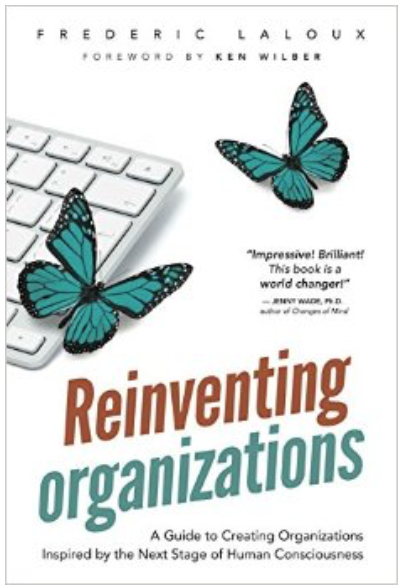
Laloux has researched and studied 12 highly successful unbounded organisations and proved scientifically what I have experienced in practice. The interesting thing from Laloux’s research is that even though all 12 of these organisations developed their methods independently they all came up with a similar formula and it is very similar to the one I have been describing. For example, one of the organisations Laloux describes is Morning Star that processes over 40% of the tomatoes in California. He says there are no bosses and yet everyone is a boss. There is no red tape and no politics yet decisions get made. Anyone can purchase what they need as long as they talk to others who may be affected.
SEMCO
One of the best examples of an unbounded organisation is the Brazilian company called Semco that was the subject of a book called “Maverick” by Ricardo Semler. In 15 years Semco grew from a few people to over 5,000, and its sales grew from $40m to $1,000m. It is based on the philosophy that much of what managers do shouldn’t be done. Workers set their own production quotas and if necessary voluntarily work overtime to meet them. Democratic decisions are made through workplace committees and for every important decision everyone has one vote. There are no fixed working hours. They rotate leadership roles and have no permanent Chief Executive. There are no written rules or policies. Despite this (maybe because of it) Semco is one of the fastest growing organisations in Brazil.
Is This The Way You Work?
Self-organisation works because it liberates unbounded human energy. When it is achieved even large organisations work with the clarity and passion of the original founders. The vision is clear and the energy to achieve it is sky-high.
The approach works because it works with nature according to our new scientific understanding of the way the world works. Is it the way you work?


